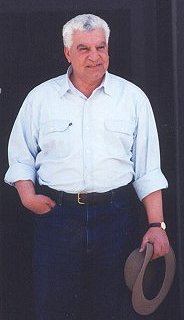The Discovery of the Tombs of the Pyramid Builders at Giza:
Dr. Zahi Hawass / Undersecretary of the State for the Giza Monuments
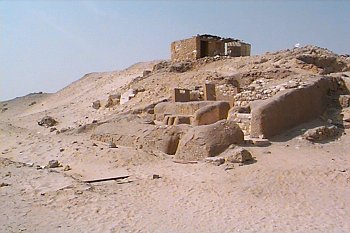 It was my dream to
discover the tombs of the workmen who built the pyramids at Giza. In my research, I
thought that the tombs and the workmen camp should be located southeast of the Sphinx. The
workmen and the farmers represent about 80% of the population of Ancient Egypt and we know
a lot about kings, Queens and Nobles but we know nothing about the common people.
It was my dream to
discover the tombs of the workmen who built the pyramids at Giza. In my research, I
thought that the tombs and the workmen camp should be located southeast of the Sphinx. The
workmen and the farmers represent about 80% of the population of Ancient Egypt and we know
a lot about kings, Queens and Nobles but we know nothing about the common people.
For centuries adventurers, scholars and tourists have drawn to the wonders of
Giza-the pyramids of Khufu, Khafre and Menkaure, the Sphinx and tombs of Old Kingdom noble
artisans who built these great monuments.
When the Greek historian Herodotus visited Egypt in the fifth century
B.C., he
was told by his guides that 100,000 workers had labored for 20 years to build Khufu's
pyramid.
Even 20,000 workers, a number closer to recent estimates, is comparable to the
populations of large cities in the Near East during the third millennium B.C.
An enormous support system must have existed at Giza for at least 67 years, the
combined minimum lengths of Khufu, Khafre and Menkaure's reigns. such support would have
included production facilities for food, ceramics and building materials (gypsum mortar,
stone, wood and metal tools); storage facilities for food, fuel and other supplies,
housing for workmen, their families and priests responsible for services in pyramid
temples that remained in use long after the main building phase was completed, and a
cemetery for workers who died in the employ of the royal necropolis.
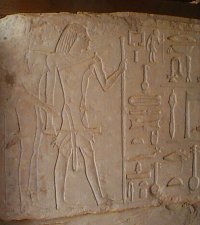 From hieroglyphic inscriptions and graffiti we infer that skilled builders and
craftsmen probably worked year round at the pyramid construction site. Peasant farmers
from the surrounding villages and provinces rotated in and out of a labor force organized
into competing gangs with names such as "friends of Khufu" and" Drunkards
of Menkaure". Each gang was divided into groups, Egyptologists call phyles (the Greek
word for tribe). There were five phyles, whose names, always the same in each gang, bear
same resemblance to ancient Egyptian neuitical terms such as "great "or
starboard and green or prow. Each phyle was divided into groups of ten to 20 men, each
named with single hieroglyphs some times representing ideas such as
"life"," endurance" and "perfection".
From hieroglyphic inscriptions and graffiti we infer that skilled builders and
craftsmen probably worked year round at the pyramid construction site. Peasant farmers
from the surrounding villages and provinces rotated in and out of a labor force organized
into competing gangs with names such as "friends of Khufu" and" Drunkards
of Menkaure". Each gang was divided into groups, Egyptologists call phyles (the Greek
word for tribe). There were five phyles, whose names, always the same in each gang, bear
same resemblance to ancient Egyptian neuitical terms such as "great "or
starboard and green or prow. Each phyle was divided into groups of ten to 20 men, each
named with single hieroglyphs some times representing ideas such as
"life"," endurance" and "perfection".
The pyramid projects must have been a tremendous socializing force in the early
Egyptian kingdom-young conscripts from hamlets and villages far and wide departing for
Giza where they entered their respective gangs, phyles and divisions in scenes reminiscent
of the most dramatic cinema spectacles of Cecil B. de Mille.
For years the support facilities, residential areas, and cemeteries of the
workers who created and maintained the pyramids remained among of the least explored areas
of ancient Egypt. But 20,000 people or three generations of pyramid builders, can not have
disappeared without leaving a trace.
Where to look?
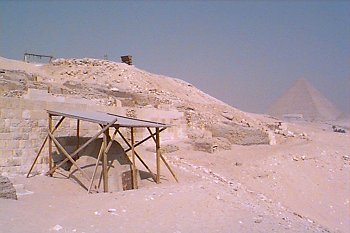 During the construction of the sewage system of the village of Nazlet-el Samman
and other villages located down the foot of the great pyramid, we found a large Old
Kingdom settlement about 3 km square.
During the construction of the sewage system of the village of Nazlet-el Samman
and other villages located down the foot of the great pyramid, we found a large Old
Kingdom settlement about 3 km square.
We recorded a continuous layer of mud-brick buildings starting about 165 feet
south of the valley Temple of Khufu and extending about 1 mile to the south. Among the
artifacts are thousands of fragments of every day pottery and bread molds, cooking pots,
beer jars and trays for sifting grain and flour. Medium to large pieces of charcoal
suggest that trees once grew here. Also domesticated animal bones, such as beef, pork and
sheep with butchers marks on them. The workmen camp should be located on this site.
I believe that there were two types of settlement, one for the workmen who
moved the stones, and the other camp for the artisans.
On the west of the
village of Nazlet-el-Samman we found the tombs of the workmen who built the pyramids.
The Great Discovery:
On April 14, 1990, the chief of the pyramid guards, Mohammed Abdel Razek,
reported to me that an American tourist was thrown from her horse when the animal stumbled
on a previously unknown mud-brick wall. Located to the south of the wall of the crow.
The mud-brick wall turned out to be a tomb, with a long vaulted chamber and two
false doors through which the dead could commune with the living and receive offerings.
Crude hieroglyphs scrawled on the false doors identified the tomb owners as
Ptah-shepsesu and his wife. At the back of the chamber were three burial shafts for the
man, his wife, and, probably, their son. In front of the tomb was a square courtyard with
low walls of broken limestone. While not in the style of the great stone mastaba tombs of
nobles beside the pyramids, Ptah-shepsesu's tomb and courtyard are grand in comparison to
others that we have uncovered around it. Pieces of granite, basalt, and diorite, stones
used in the pyramid temples, had been incorporated into the walls. Such material suggests
that some tombs in the cemetery may belong to the pyramid builders or succeeding
generations of workers who made use of stone left over from the construction of the
pyramids, temples, and tombs. Attached to Ptah-shepsesu's tomb were small shaft burials of
people who probably worked under him.
 |
The lower part of the cemetery contains about 600 such graves for workmen and
30 larger tombs, perhaps for overseers. The tombs come in a variety of forms: stepped
domes, beehives, and gabled roofs. Two to six feet high, the domes covered simple
rectangular grave pits, following the configuration of the pyramids in an extremely
simplified form. One small tomb featured a miniature ramp leading up and around its dome.
Could the builder have intended it to represent the construction ramp of a royal pyramid?
Other tombs resemble miniature mastabas with tiny courtyards and stone false doors with
the names and titles of the deceased inscribed on them.
We dubbed one remarkable grave the "egg-dome" tomb. An outer
dome, formed of mud brick plastered smooth with tafia, enclosed an egg-shaped corbelled
vault built over a rectangular burial pit. What was the meaning of the double dome?
Egyptologists believe that mounds left inside large Dynasty I (ca. 2920-2770 B.C.) tombs
and rock protrusions in the pyramids themselves represented a primeval mound of creation
that magically ensured resurrection. The same idea may have been in the minds of those who
built this tomb.
|
| We have found many false doors and some stelae attached to these tombs.
Inscribed in crude hieroglyphs, they record the names of the people whose skeletons lay
below: on one stela a man named Khemenu is depicted sitting at an offering table in front
of his wife, Tep-em nefret; a false door is inscribed with a woman's name, Hetep-repyt
(Offering to Presiding Goddess, or Hathor); another belongs to Hy, priestess of the
goddess Hathor, Lady of (the) Sycamore Tree, and her son Khuwy. These women, the wives of
the pyramid builders, served as priestesses of Hathor, goddess of love, music, dance, and
the necropolis, and a counterpart to Horus, god of kingship. |
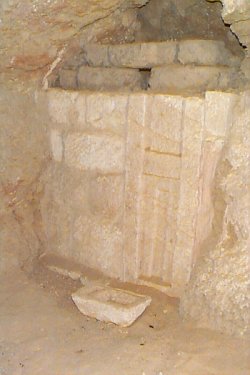 |
Small stone figurines in a rectangular niche attached to a little mud-brick
mastaba represent a household of these workers. One of the statuettes depicts a woman
seated on a backless chair with her hands on her knees. An inscription on the chair
identifies her as Hepeny-kawes. She wears a black wig with hair parted in the middle and
reaching to her shoulders. She has large eyes typical of Old Kingdom depictions. Her body
is well modeled under a white robe that covers all but her feet. A second statuette, badly
damaged by salt, depicts her husband, Kaihep. A third statuette is of a kneeling woman,
possibly a servant, grinding grain. She wears a beaded collar and a short black wig with
carefully rendered locks held in place by a band of white cloth tied around her forehead.
Her arms and shoulders suggest the strength needed for her work, and she wears
a red bracelet on her right wrist. The oval grinding stone has traces of red paint,
probably to represent granite, and is painted white in the middle to indicate flour, which
is being collected into a sack held between her legs. The statues represent a simple
household: man, wife, and servant. Alternatively, the woman grinding grain could be the
wife doing her own chores. Similar sets of statues representing larger households include
potters, butchers, brewers, and bakers.
Women in the lower cemetery were either buried with their husbands or in tombs
next to them. Two women however, were found in their own tombs. One is identified as
Repyet-Hathor, a priestess of Hathor, by an inscription on a small offering basin placed
in front of her false door. The tomb of the second, named Nubi, was considerably grander
than Repyet-Hathor's. She was a priestess of Neith, goddess of Sais, an important cult
center in the Nile Delta. Two especially interesting burials were those of dwarf women,
little more than three feet tall, one of whom who had apparently died in childbirth - we
found the skeleton of an infant within her remains.
As we excavated the lower cemetery, we came upon a ramp that ran up the slope
to the west to an upper level of burials. These upper tombs, so far numbering 43, are
larger and more elaborate than those of the lower part of the cemetery. Many are
completely rock-cut or have a stone facade in front of a low cliff face. Others are built
of limestone and mud brick in the mastaba style. We found higher quality artifacts and
statuary in these tombs, and the painted and inscribed false doors are also superior to
the scrawled texts from the lower tombs. The skeletal remains, as in the lower cemetery,
were found in shafts two to three feet underground, most in a fetal position, and many in
wooden coffins.
Titles such as" overseer of the side of the pyramid,"" director
of the draftsmen," "overseer of masonry," "director of workers,"
and "inspector of the craftsmen" are another indication that those buried in the
upper part of the cemetery were of higher status than the people buried below. Perhaps the
most important title we found was the "director for the king's work." I believe
some of these are the tombs of the artisans who designed and decorated the Giza pyramid
complexes and the administrators who oversaw their construction. We need, however, to
analyze the names, pottery, and decoration of the tombs further to be sure they date to
the time when the Giza pyramids were being built.
The ramp from the lower cemetery led to a small rectangular court with wails of
broken limestone. A shorter second ramp, its floor paved with mud and stone rubble and its
side walls made of limestone and granite pieces, extended from the west wall of the court.
Pottery from this ramp and court dates to the end of Dynasty 4 and the beginning of
Dynasty 5. A mud seal impression found in the bed of the ramp can be read as Djed-khau
(Enduring of Diadems), one of the official names of Djedkare Isesi, a pharaoh of Dynasty
5. This is another chronological indicator suggesting that much of this cemetery dates a
few generations after the kings who built the Giza pyramids.
At the end of the second ramp were two children's graves with no offerings, and
a mastaba tomb. Built of limestone and similar in style to those of Dynasty 4, the tomb
had six burial shafts sunk through it and two false doors carved on its eastern face. The
ramp from the lower cemetery reminded us of the causeways that led from the Nile Valley to
the pyramids on the high plateau. The court could be compared to the pyramid valley
temple, while the mastaba took the place of a pyramid.
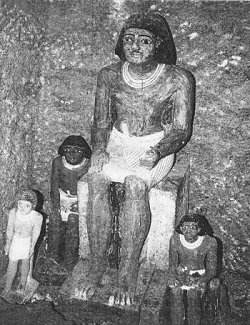 |
Attached to the mastaba tomb, but separate from it, was a room cut into the
bedrock. Inside was an intact burial with pottery. A niche carved into the west side of
the chamber was sealed, except for a small hole, with limestone, mud bricks, and mud
mortar. We peered inside and were astonished to see the eyes of a statue staring back at
us. We were even more surprised when we removed the mud bricks and limestone blocks and
found not one but four statues: a large one in the middle flanked by two smaller ones to
the right and one to the left. There had two on the left, but one, made of wood, had
disintegrated into a heap of powder. All four surviving statues are inscribed, "the
overseer of the boat of the goddess Neith, the king's acquaintance, Inty-shedu," it
seems that Inty-shedu was a carpenter who made boats for the king or the goddess Neith.
The middle statue shows Inty-shedu at the time of his death. The standing statue to the
right and the surviving statue to the left depict him in his youth. The sealed statue to
the right depicts him at an older age. The artist carved each face to indicate a stage of
life and sculpted muscles and shoulders to show corresponding strength. This group of five
statues recalls the five statues of the pharaohs placed in most pyramid temples from the
time of Khafre to the end of the Old Kingdom. |
 One of the more interesting artisans' tombs is that of Nefer-theith and his
wife Nefer-hetepes. Though simple, it is inscribed with beautiful hieroglyphic writing. It
contains three limestone false doors and stelae with the name of the deceased, his two
wives, and his 18 children. The false doors of his tomb are unique for their scenes of
grain grinding, and bread and beer making. Was Nefer-theith the supervisor for the bakery
recently found in the plain below? There is also a list of feast days and offerings for
the deceased including bread, beer, birds, and oxen. On the false door of
Nefer-hetepes,
his primary wife, is a list that records offerings of natron (a combination of baking soda
and salt used in mummification), sacred water, oil, incense, kohl (black eye paint), 14
types of bread, cakes, onions, beef, grain, figs and other fruits, beer, and wine.
Nefer-hetepes held the title "one known by the king, weaver." On the third false
door, two stelae represent Nefer-theith standing while below him a man makes beer and
another person pours it into four jars.
One of the more interesting artisans' tombs is that of Nefer-theith and his
wife Nefer-hetepes. Though simple, it is inscribed with beautiful hieroglyphic writing. It
contains three limestone false doors and stelae with the name of the deceased, his two
wives, and his 18 children. The false doors of his tomb are unique for their scenes of
grain grinding, and bread and beer making. Was Nefer-theith the supervisor for the bakery
recently found in the plain below? There is also a list of feast days and offerings for
the deceased including bread, beer, birds, and oxen. On the false door of
Nefer-hetepes,
his primary wife, is a list that records offerings of natron (a combination of baking soda
and salt used in mummification), sacred water, oil, incense, kohl (black eye paint), 14
types of bread, cakes, onions, beef, grain, figs and other fruits, beer, and wine.
Nefer-hetepes held the title "one known by the king, weaver." On the third false
door, two stelae represent Nefer-theith standing while below him a man makes beer and
another person pours it into four jars.
The tomb of a man named Petety has a unique form with three open courts. In
contrast to Nefer-theith and his wives, Petety and his wife Nesy-Sokar are depicted
separately. A priestess of the goddess Hathor, Nesy-Sokar is also described as beloved of
the goddess, Neith. She is shown standing on the doorjamb of the chapel in the traditional
pose: one arm raised on her breast and the other behind her back. She wears a tight dress
that leaves the breasts bare, a collar, and a broad necklace. Her hair is divided in front
and behind her shoulders. The artist has portrayed her with her head tilted slightly up
and forward, perhaps a realistic touch caused by wearing the wide, tight collar. This
gives her face a bold and confident expression enhanced by the darkly outlined eye.
On either side of the
entrance to the tomb we found examples of hieroglyphic curses to protect it. Petety's
curse reads:
Listen all of you! The
priest of Hathor will beat twice any one of you who enters this tomb or does harm to it.
The gods will confront him because I am honored by his Lord.
The gods will not allow anything to happen to me.
Anyone who does anything bad to my tomb, then (the) crocodile, (the) hippopotamus, and the
lion will eat him.
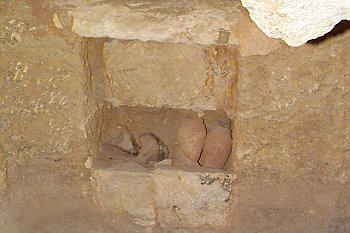 Based on the pottery, names, and titles found in association with the tombs,
the cemetery was begun as early as the reign of Khufu in Dynasty 4 and continued through
the end of Dynasty 5, from ca. 2551 to 2323 B.C. The cemetery probably extends across the
escarpment above the low desert plain where we have found production and storage
facilities. It seems to be an Old Kingdom version of the New Kingdom (ca.1500-1163 B.C.)
cemetery at Deir el-Medineh, where workers who excavated and decorated the royal tombs in
the Valley of the Kings were buried. We believe that so far we have found only 20 percent
of the tombs buried under the sand along this slope.
Based on the pottery, names, and titles found in association with the tombs,
the cemetery was begun as early as the reign of Khufu in Dynasty 4 and continued through
the end of Dynasty 5, from ca. 2551 to 2323 B.C. The cemetery probably extends across the
escarpment above the low desert plain where we have found production and storage
facilities. It seems to be an Old Kingdom version of the New Kingdom (ca.1500-1163 B.C.)
cemetery at Deir el-Medineh, where workers who excavated and decorated the royal tombs in
the Valley of the Kings were buried. We believe that so far we have found only 20 percent
of the tombs buried under the sand along this slope.
None of the workers was mummified, a prerogative of royalty and nobility, but
many tombs in this cemetery contained skeletal remains that tell us much about the lives
of these people. Study of the remains by Azza Sarry el-Din and Fawziya Hussein of Egypt's
National Research Center reveals that males and females were equally represented, mostly
buried in fetal positions, with face to the east and head to the north. Many of the men
died between age 30 and 35. Below the age of 30 a higher mortality was found in females
than in males, a statistic undoubtedly reflecting the hazards of childbirth.
Skeletons from the great mastaba cemetery west of the Khufu pyramid, in which
members of the upper class were buried, reflect a healthier population whose women lived
five to ten years longer than those of the artisan and worker community.
Degenerative arthritis occurred in the vertebral column, particularly in the
lumbar region, and in the knees. It was frequent and more severe than in the skeletons
from
the mastaba cemetery. Skeletons of both
men and women, particularly those from the lower burials, show such signs of heavy labor.
Simple and multiple limb fractures were found in skeletons from both the lower
and upper burials. The most frequent were fractures of the ulna and radius, the bones of
the upper arm, and of the fibula, the more delicate of the two lower leg bones. Most of
the fractures had healed completely, with good realignment of the bone, indicating that
the fractures had been set with a splint. We found two cases, both male, that suggested
amputation, of a left leg and a right arm. The healed ends of the bones indicate that the
amputations were successful. Few other cases of amputation have been recorded in Egyptian
archaeology. Depressed fractures of the frontal or parietal skull bones were found in
skulls of both males and females. The parietal lesions tended to be left-sided, which may
indicate that the injuries resulted from face to face assault by right-handed attackers.
We should contrast the evidence of the tombs and of medical treatment with the
notion that pharaohs used slave labor to build the giant pyramids, an idea as old as
Herodotus. The scenario of whip-drive slaves received support from the biblical account of
Moses and the Exodus and the first-century A.D. historian Josephus. In our era, Cecil B.
de Mille's galvanizing screen images reinforced this popular misconception.
The pyramid builders were
not slaves but peasants conscripted on a rotating part-time basis, working under the
supervision of skilled artisans and craftsmen who not only built the pyramid complexes for
the kings and nobility, but also designed and constructed their own, more modest tombs.
I hope that people who
believe that the pyramids belong to lost civilization can read the story of this discovery
and understand that until now, everything we have found at Giza dates the pyramid and the
sphinx to Dynasty 4, about 4600 years ago.

 It was my dream to
discover the tombs of the workmen who built the pyramids at Giza. In my research, I
thought that the tombs and the workmen camp should be located southeast of the Sphinx. The
workmen and the farmers represent about 80% of the population of Ancient Egypt and we know
a lot about kings, Queens and Nobles but we know nothing about the common people.
It was my dream to
discover the tombs of the workmen who built the pyramids at Giza. In my research, I
thought that the tombs and the workmen camp should be located southeast of the Sphinx. The
workmen and the farmers represent about 80% of the population of Ancient Egypt and we know
a lot about kings, Queens and Nobles but we know nothing about the common people.  From hieroglyphic inscriptions and graffiti we infer that skilled builders and
craftsmen probably worked year round at the pyramid construction site. Peasant farmers
from the surrounding villages and provinces rotated in and out of a labor force organized
into competing gangs with names such as "friends of Khufu" and" Drunkards
of Menkaure". Each gang was divided into groups, Egyptologists call phyles (the Greek
word for tribe). There were five phyles, whose names, always the same in each gang, bear
same resemblance to ancient Egyptian neuitical terms such as "great "or
starboard and green or prow. Each phyle was divided into groups of ten to 20 men, each
named with single hieroglyphs some times representing ideas such as
"life"," endurance" and "perfection".
From hieroglyphic inscriptions and graffiti we infer that skilled builders and
craftsmen probably worked year round at the pyramid construction site. Peasant farmers
from the surrounding villages and provinces rotated in and out of a labor force organized
into competing gangs with names such as "friends of Khufu" and" Drunkards
of Menkaure". Each gang was divided into groups, Egyptologists call phyles (the Greek
word for tribe). There were five phyles, whose names, always the same in each gang, bear
same resemblance to ancient Egyptian neuitical terms such as "great "or
starboard and green or prow. Each phyle was divided into groups of ten to 20 men, each
named with single hieroglyphs some times representing ideas such as
"life"," endurance" and "perfection".  During the construction of the sewage system of the village of Nazlet-el Samman
and other villages located down the foot of the great pyramid, we found a large Old
Kingdom settlement about 3 km square.
During the construction of the sewage system of the village of Nazlet-el Samman
and other villages located down the foot of the great pyramid, we found a large Old
Kingdom settlement about 3 km square. 


 One of the more interesting artisans' tombs is that of Nefer-theith and his
wife Nefer-hetepes. Though simple, it is inscribed with beautiful hieroglyphic writing. It
contains three limestone false doors and stelae with the name of the deceased, his two
wives, and his 18 children. The false doors of his tomb are unique for their scenes of
grain grinding, and bread and beer making. Was Nefer-theith the supervisor for the bakery
recently found in the plain below? There is also a list of feast days and offerings for
the deceased including bread, beer, birds, and oxen. On the false door of
Nefer-hetepes,
his primary wife, is a list that records offerings of natron (a combination of baking soda
and salt used in mummification), sacred water, oil, incense, kohl (black eye paint), 14
types of bread, cakes, onions, beef, grain, figs and other fruits, beer, and wine.
Nefer-hetepes held the title "one known by the king, weaver." On the third false
door, two stelae represent Nefer-theith standing while below him a man makes beer and
another person pours it into four jars.
One of the more interesting artisans' tombs is that of Nefer-theith and his
wife Nefer-hetepes. Though simple, it is inscribed with beautiful hieroglyphic writing. It
contains three limestone false doors and stelae with the name of the deceased, his two
wives, and his 18 children. The false doors of his tomb are unique for their scenes of
grain grinding, and bread and beer making. Was Nefer-theith the supervisor for the bakery
recently found in the plain below? There is also a list of feast days and offerings for
the deceased including bread, beer, birds, and oxen. On the false door of
Nefer-hetepes,
his primary wife, is a list that records offerings of natron (a combination of baking soda
and salt used in mummification), sacred water, oil, incense, kohl (black eye paint), 14
types of bread, cakes, onions, beef, grain, figs and other fruits, beer, and wine.
Nefer-hetepes held the title "one known by the king, weaver." On the third false
door, two stelae represent Nefer-theith standing while below him a man makes beer and
another person pours it into four jars.  Based on the pottery, names, and titles found in association with the tombs,
the cemetery was begun as early as the reign of Khufu in Dynasty 4 and continued through
the end of Dynasty 5, from ca. 2551 to 2323 B.C. The cemetery probably extends across the
escarpment above the low desert plain where we have found production and storage
facilities. It seems to be an Old Kingdom version of the New Kingdom (ca.1500-1163 B.C.)
cemetery at Deir el-Medineh, where workers who excavated and decorated the royal tombs in
the Valley of the Kings were buried. We believe that so far we have found only 20 percent
of the tombs buried under the sand along this slope.
Based on the pottery, names, and titles found in association with the tombs,
the cemetery was begun as early as the reign of Khufu in Dynasty 4 and continued through
the end of Dynasty 5, from ca. 2551 to 2323 B.C. The cemetery probably extends across the
escarpment above the low desert plain where we have found production and storage
facilities. It seems to be an Old Kingdom version of the New Kingdom (ca.1500-1163 B.C.)
cemetery at Deir el-Medineh, where workers who excavated and decorated the royal tombs in
the Valley of the Kings were buried. We believe that so far we have found only 20 percent
of the tombs buried under the sand along this slope. 